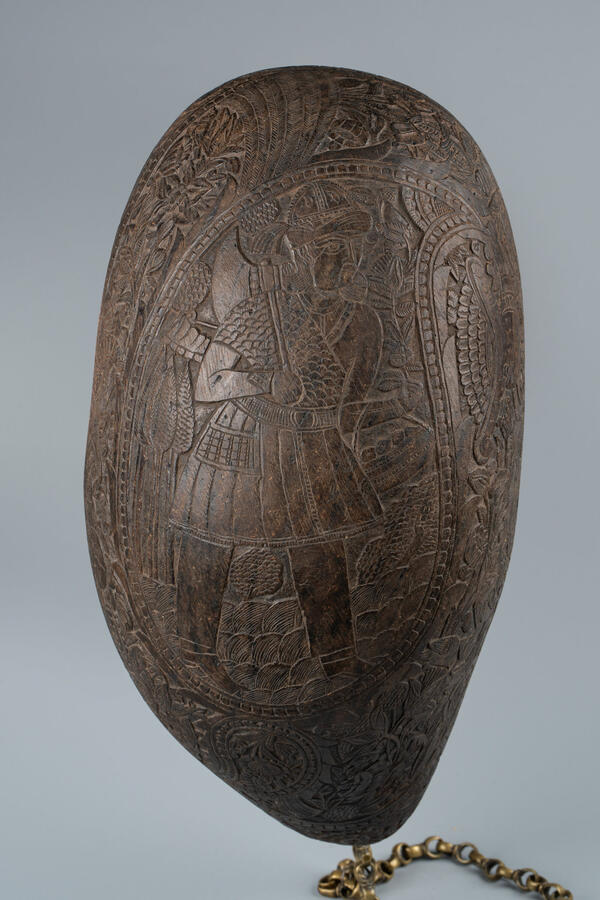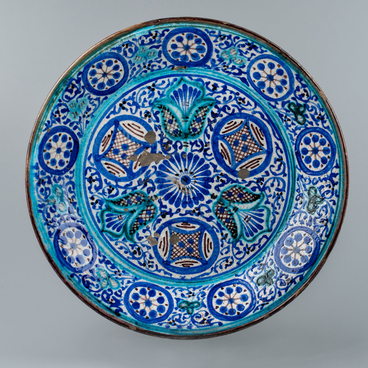The Samara Regional Art Museum displays an Iranian kashkul made of sea coconut with a chain. A kashkul is a vessel of a specific shape, which wandering dervishes (ascetics) used for eating, drinking and collecting alms. Kashkuls were also used as vessels for storing water or refreshing drinks when quenching the thirst of mourners at funerals and memorial ceremonies. It is a half of the world’s largest nut, known as sea coconut, double coconut.
The dervish bowl from the museum is richly decorated with carved floral patterns. On one side of the kashkul, there is an image of a young man with a kashkul holding a flower in one hand and a tabarzin axe in the other. There is a scene with a rider shooting a predator with a gun on the other side of the bowl. Kashkuls of this kind are true artworks that combine features of applied arts, calligraphy and miniature painting.
The double coconut palms, which now grow on the coast of the Indian Ocean, originally grew only in one place: on five closely located small islands in the Seychelles archipelago in the western Indian Ocean. The main currents of the Indian Ocean are directed from west to east, and therefore nuts that fell into the water were carried by the currents to the coast of South and Southeast Asia, where they were traditionally considered very valuable finds due to the unusual nature of their bipartite shape and the mysterious origin.
The travelers’ tradition of carrying kashkuls with them as a bowl, apparently, was brought into Iran from India. The contacts of the Sufis of these two countries in the period from 1510 to 1737 were especially active. Along with the kashkul, stories about its mythical and magical properties, and the healing power hidden in it were also brought into Iran. These stories became part of Iranian folklore, although they were of Indian origin. However, the kashkul was associated with dervishes, thanks to which its function as a talisman began to change and it turned primarily into a symbol of devotion to the path of religious poverty. If a student neglected their obligations, the master could deprive them of the right to wear the kashkul.
Sufi artisans decorated the surface of the kashkul with intricate patterns, poems and portraits of their master, as well as surahs from the Koran.
The dervish bowl from the museum is richly decorated with carved floral patterns. On one side of the kashkul, there is an image of a young man with a kashkul holding a flower in one hand and a tabarzin axe in the other. There is a scene with a rider shooting a predator with a gun on the other side of the bowl. Kashkuls of this kind are true artworks that combine features of applied arts, calligraphy and miniature painting.
The double coconut palms, which now grow on the coast of the Indian Ocean, originally grew only in one place: on five closely located small islands in the Seychelles archipelago in the western Indian Ocean. The main currents of the Indian Ocean are directed from west to east, and therefore nuts that fell into the water were carried by the currents to the coast of South and Southeast Asia, where they were traditionally considered very valuable finds due to the unusual nature of their bipartite shape and the mysterious origin.
The travelers’ tradition of carrying kashkuls with them as a bowl, apparently, was brought into Iran from India. The contacts of the Sufis of these two countries in the period from 1510 to 1737 were especially active. Along with the kashkul, stories about its mythical and magical properties, and the healing power hidden in it were also brought into Iran. These stories became part of Iranian folklore, although they were of Indian origin. However, the kashkul was associated with dervishes, thanks to which its function as a talisman began to change and it turned primarily into a symbol of devotion to the path of religious poverty. If a student neglected their obligations, the master could deprive them of the right to wear the kashkul.
Sufi artisans decorated the surface of the kashkul with intricate patterns, poems and portraits of their master, as well as surahs from the Koran.





